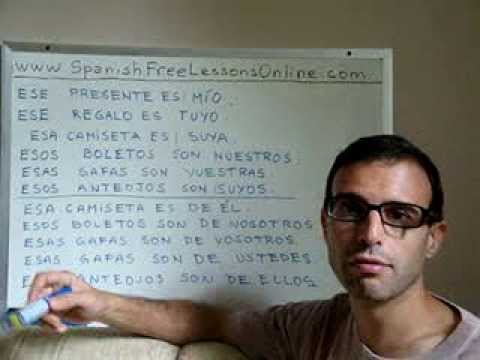Possessive Pronouns in Spanish
Since Possessive Pronouns in Spanish are so related to Possessive Adjectives, lets begin by explaining the main different between both of them:
- Pronouns: They take the place of a noun
- Adjectives: They only describe a nouns or provide additional information
Therefore, lets take a look at these two sentences below and see the difference:
- Mi libro es verde – My book is green
- El mío es verde – Mine is green
The first sentence is an example of a Possessive Adjective. You can see that the word “mi” (my) provides additional information. It tells that whatever we are talking about is mine.
The second sentence is an example of a Possessive Pronoun in Spanish. Here you can see that the word “mío” (mine) is, in fact, replacing the noun.
Now that you understand the difference between Possessive Pronouns in Spanish and Possessive Adjectives, let focus on the first one. We have already focused on Spanish Possessive Adjectives in our Lesson 23 and Lesson 24 (Sentences involving Spanish possessive adjectives).
Possessive Pronouns in Spanish – Examples
- Ese presente es mío – That present is mine
- Ese regalo es tuyo – That present is yours
- Esa camiseta es suya – That t-shirt is his/hers/yours (formal)
- Esos boletos son nuestros – Those tickets are ours
- Esas gafas son vuestras – Those glasses are yours (plural; used in Spain)
- Esos anteojos son suyos – Those glasses are theirs/yours (plural; used in Latin-America)
Another way of rewriting the same sentences without using possessive pronouns in Spanish
- Esa camiseta es de él/ella/usted – That t-shirt is his/hers/yours (formal)
- Esos boletos son de nosotros – Those tickets are ours
- Esas gafas son de vosotros – Those glasses are yours (plural; used in Spain)
- Esas gafas son de ustedes – Those glasses are yours (plural; used in Latinamerica)
- Esos anteojos son de ellos – Those glasses are theirs
I recommend all my students that follow my online courses to do the exams that I upload to my website. The topic of this lesson (Possessive Pronouns in Spanish) is included in Spanish Quiz Nbr. 5 (lessons 27 – 34).
You can find a full list of all the video lessons by clicking on the List of Lessons tab on the Main Menu.
To enlarge the video-screen to full-size, click on the right icon on the lower right corner of the video.














esas gafas son de vosotros…. why is it vosotros and not vosotras since glasses are feminine plural?
That is because “vosotros” refers to the gender of the persons the glasses belong to.
Spanish possessive pronouns (mi, mis, tu, tus, su, sus, etc) relate to the object and to the person that the object belongs to. But Spanish subject pronouns (yo, tú, él/ella, nosotros, vosotros, ellos) only refer to the person or group of persons.
If “vosotros” were a group of women, then it would be “vosotras”. But we would use “vosotros” (male) under any of these conditions:
– The group of people is formed only by men.
– The group of people is formed by men and women.
– We don’t know whether the group is formed by men or women.